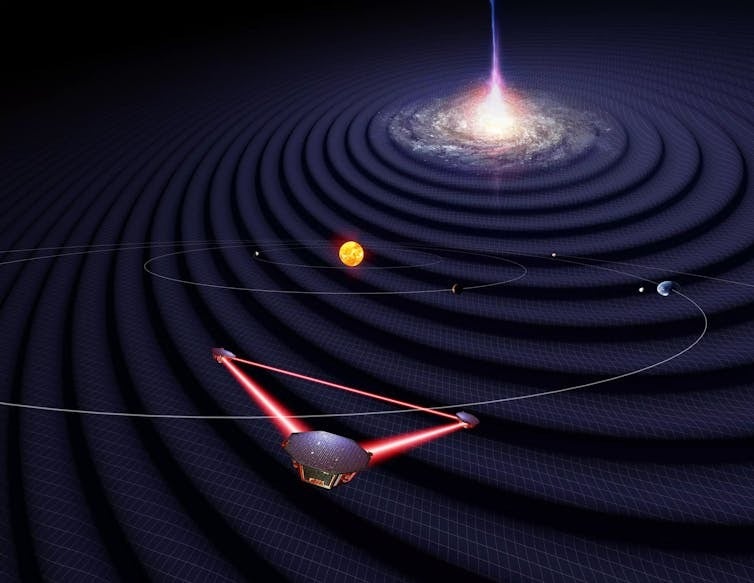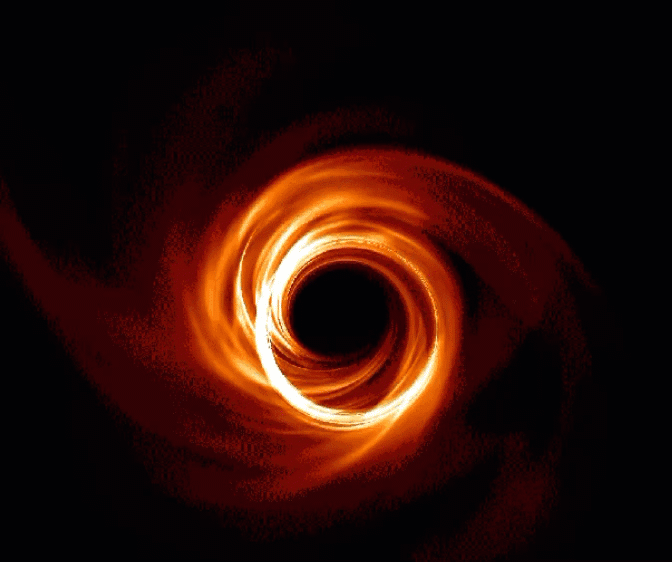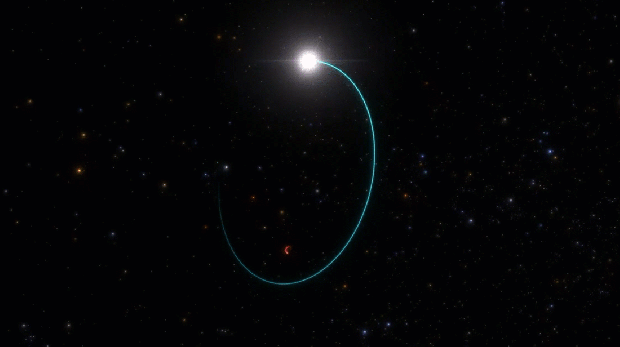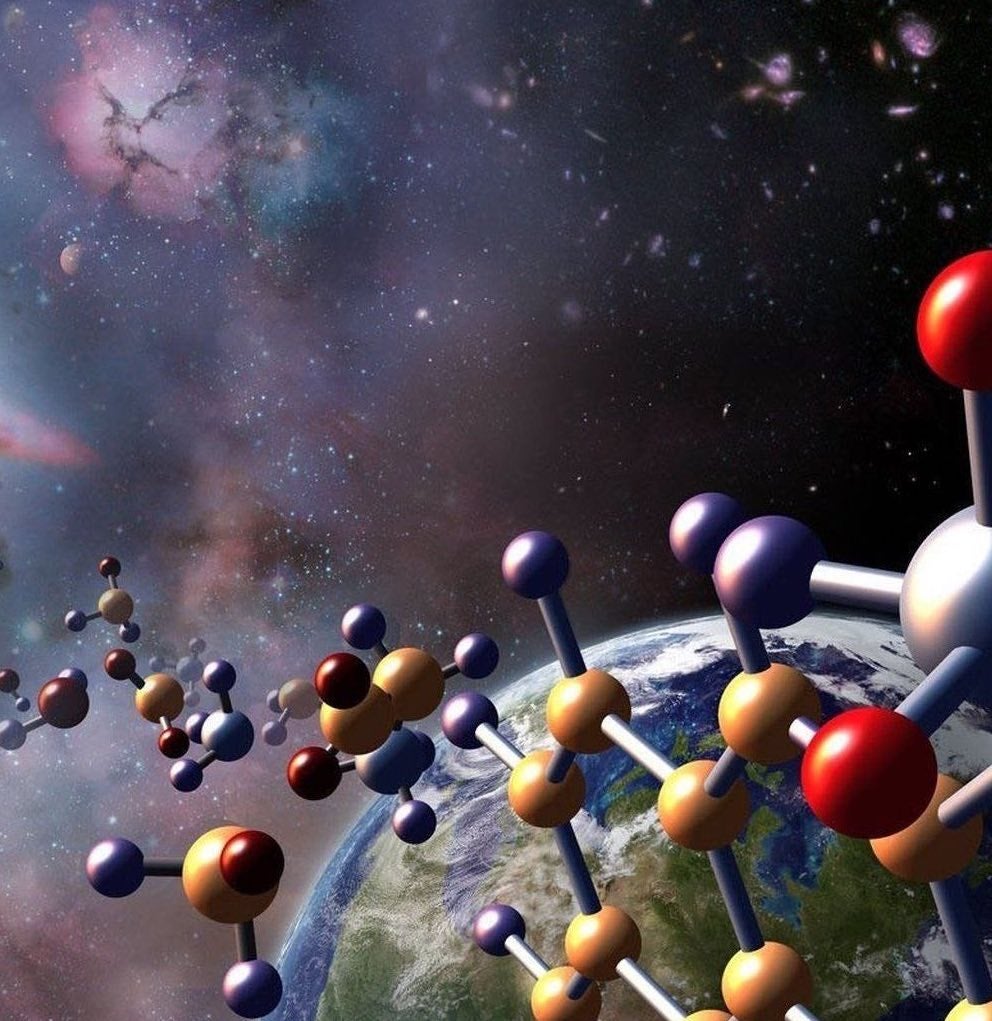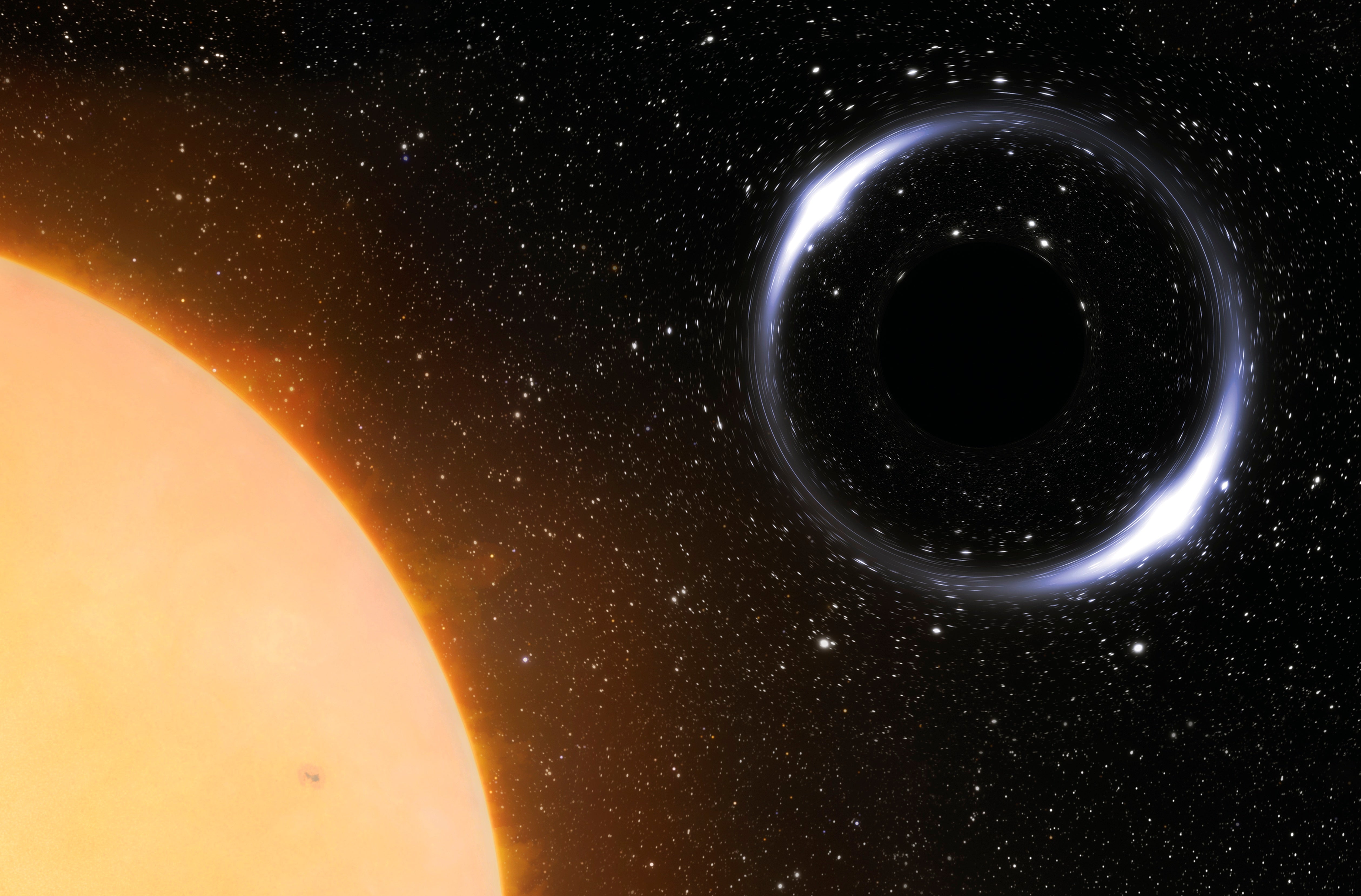
In a universe full of fascinating and exotic phenomena, few objects challenge the imagination quite like black holes.
Discovering new black holes, however, is no easy feat — where do you even begin to look for them? Recent research has found a new category that includes the closest black holes we know of.
As an astronomer, I have studied black holes for many years, and know firsthand that finding new ones isn’t as simple as one would like. The first thing to consider is that, well, they’re black: Their gravity is so strong that even light — the fastest thing in the universe — cannot escape the event horizon, or point of no return. This means astronomers can only detect black holes through their interactions with other nearby objects. For example, we know a supermassive black hole called Sagittarius A* (Sgr A*) lurks in the center of our Milky Way Galaxy, weighing more than 4 million times the mass of the Sun. Astronomers first got an idea of the black hole’s existence by watching stars zooming around an invisible object there — a result striking enough to win the 2020 Nobel Prize in physics. Two years later, in May 2022, members of the Event Horizon Telescope announced they had successfully linked radio telescopes around the globe to photograph Sgr A*. The picture shows a spectacular ring of hot plasma just outside the event horizon itself, created by the black hole accreting stray gas that wanders too close.
Black holes are the worst hosts

But while our galaxy contains just one supermassive black hole, it plays host to numerous smaller black holes, formed after massive stars (over 18 times the mass of our Sun) collapse at the end of their lives and explode in a supernova. We know of several such black holes specifically in binary systems, thanks to the dance their stellar companions perform. The most famous is the black hole Cygnus X-1 (Cyg X-1), one of the brightest X-ray sources in the sky despite its location some 7,000 light-years away. Cyg X-1 was the first source widely accepted to be a black hole — in fact, astrophysicists Kip Thorne and Stephen Hawking famously made a wager in the 1970s over whether Cyg X-1 was a black hole or not. Thorne was in favor of a black hole and Hawking against. Hawking was happy to concede in the early 1990s once the evidence was clear.
Today, astronomers know Cyg X-1 is a black hole about 21 times the Sun’s mass, accompanied by a blue supergiant star orbiting it at just 20 percent the distance between Earth and the Sun. (Astronomers call the average Earth-Sun distance an astronomical unit, or AU.) The blue supergiant has a mass between 20 and 40 solar masses — it, too, will become a black hole someday — and its stellar wind sends a steady stream of particles falling onto Cyg X-1, a process called accretion. It is this process that fuels the bright X-ray emission we see. Several other black holes (and even neutron stars) have also been discovered this way, as material from a close companion accretes onto the compact object, creating a class of objects called X-ray binaries.
X-ray binaries are a special, atypical kind of system. The black hole and the star must be very close for the emission to be detectable. So, what about the binary systems with greater distances between the two objects? And what about the black holes with no companion and thus nothing nearby to accrete? Is there a way to find black holes such as these?
Historically, the answer was no. Lone black holes are, as I said, black. But a few months ago, that answer changed due to the efforts of the European Space Agency (ESA) mission Gaia and an astronomer named Kareem El-Badry.

Gaia: Mother of life and precise data
Kareem is currently an assistant professor of astronomy at Caltech. He set out to find black holes while in graduate school at the University of California, Berkeley. “I spent a lot of time during my Ph.D. trying to find nonaccreting black holes, unsuccessfully,” he recalls. I first met Kareem when we were both astronomy postdocs at Harvard University, when he already held a reputation in the field as “the black hole debunker” — though this wasn’t his intention. This was because Kareem devoted time to confirming allegedly discovered black holes in papers published by other astronomers. But when he examined the data, he found no black holes — in other words, what Kareem did find was that none of these black hole candidates stood up to scrutiny. “They just weren’t there, and also the methods [used to identify candidates] weren’t optimal,” he says.
However, one potential method used for finding black holes did catch Kareem’s attention. It involved the Gaia satellite. Launched in 2013, Gaia is designed for astrometry, meaning it collects the precise locations of millions of stars. Gaia achieves this by carefully measuring a star’s position in the sky every several months. As more time passes, the more precise the data for each star become. Every few years, a new Gaia data release updates previous catalogs to great fanfare from researchers.
When the latest Gaia data release occurred in June 2022 (named Gaia DR3), Kareem was ready: He ran a computer script on the massive new catalog within five minutes of its release. He was looking specifically for stars with a “wobble” in their orbit, caused by an unseen black hole companion. When a star is in a gravitationally bound system with another object, the two (or three, or however many) objects orbit a common center of mass, called the barycenter. Even if the second object is unseen, the star will appear to move back and forth from our point of view on Earth. Once its orbit is established, astronomers can apply Kepler’s laws of planetary motion to find the mass of the companion. Astronomers often use this technique to discover exoplanets; however, before Gaia the data weren’t nearly precise enough to go after black holes. Today, the precision of Gaia allows astronomers to check the positions of suspected X-ray binary activity for such wobbles, as well as find wobbling stars to investigate as potential X-ray binaries.
Now, with Gaia DR3 in Kareem’s capable hands, two stars stood out among the millions of others in the database. And with all the analyses complete, it turns out they are orbiting the two closest black holes to Earth.
Does this puzzle piece belong?

The first star in question is about as Sun-like as they get. It’s about the same size and mass as the Sun, lying 1,560 light-years away. The star is bright enough to be easily spotted by a professional telescope. However, the similarities end there. Unlike our Sun, this star is orbiting an invisible, massive companion every six months, at roughly the distance between Mars and the Sun. Follow-up observations to confirm the orbit indicated the unseen object was 10 times the mass of the Sun, making it much more massive than the visible star. And it couldn’t be another star because one that massive would be brighter and more easily spotted than the first star — plus, nothing else known can be as weighty and yet still dark. The simple process of elimination led to the conclusion that the invisible companion must be a black hole. Kareem named it Gaia BH1: the closest known black hole to Earth.
The discovery made headlines and rocked the astronomical world. Not only is Gaia BH1 three times closer than the now-outranked closest black hole, V616 Monocerotis, but it’s a dormant black hole, which means that it doesn’t pull material from its companion to form an accretion disk. Such an object had never been discovered before. “Because the orbit’s as wide as it is, we can look at the evolution of the black hole itself,” explains Katie Breivik, an astronomer at Carnegie Mellon University who studies how stars and black holes evolve. “This thing is an amazing gold mine for studying how black holes form.”
One unknown factor is how the system formed in the first place. “Binary interactions shrink orbits over time,” says Breivik, “and at present we basically think it’s impossible to create a black hole like this in isolation.” In other words, we don’t understand how the Gaia BH1 system (with its black hole and its Sun-like star) came to be because all previously known black holes in binary systems likely evolved by sharing material with their companion while both were still stars. What’s more, the Sun-like companion appears completely untouched, with no evidence of any previous close interactions with another star or black hole. “That’s a puzzle,” Breivik says.
There are a few possibilities on the table: for example, if this were originally a triple system, where one companion was either ejected or swallowed by the black hole. But confirming such a history would be extremely difficult. Alternatively, perhaps the Sun-like star and the star that eventually became Gaia BH1 were both born in the same crowded cluster of stars and got nudged into a common orbit. That’s also a tough scenario to prove at this stage, millions of years later.
The discovery led to other questions as well: Was Gaia BH1 truly dormant? Was it the only object like it out there? That’s where I came in.
To detect, or not to detect

If Kareem’s scientific reputation lies in debunking (and sometimes finding) black holes, my own lies in detecting radio emission from black holes, usually as they tear stars apart and eat them. (See my story in the December 2021 issue, “How to swallow a star.”) When the news of Gaia BH1 came out in late 2022, my office at Harvard was down the hall from Kareem’s, so I had to run in and ask: Had he or his colleagues considered a dedicated observation of the source with the Very Large Array (VLA) in New Mexico? After all, that Sun-like star has a solar wind of particles, just like that of our own Sun. And at such a “close” distance to us, a few hours of VLA time would likely be enough to either detect emission as these particles fall into the black hole, or to establish that it must have a very low rate of accretion.
Kareem agreed and proceeded to secure the required VLA observation time to get a better look. Unfortunately, no radio waves popped up at Gaia BH1’s location. But it wasn’t all bad news — a few days later, while commiserating the result, Kareem mentioned: “You know, I have a second candidate in the Gaia data, which would be the second-closest black hole to Earth if proven. And it might be a better bet for detecting radio emission, but it’s in the Southern Hemisphere. Interested?”
I don’t think anyone who becomes an astronomer would say no to an opportunity like that. Kareem filled me in on the details: At 3,800 light-years away, Gaia BH2 is farther than Gaia BH1. It lies 5 AU from its binary star companion (roughly the distance from the Sun to Jupiter), which means one orbit takes 3.5 years to complete. However, as luck would have it, the pair would approach each other most closely (known as periastron) in February 2023. And what’s more, the star in this case is a red giant. Our own Sun will someday become a red giant as it begins to run out of hydrogen in its core, swelling up, cooling off (which turns it red), and developing a much stronger stellar wind. So, Gaia BH2 might be farther from Earth than Gaia BH1, but the star’s stronger stream of particles made it a far better bet that we’d detect emission from accretion onto the black hole. And if we still didn’t detect anything, it would mean we’d confirmed a new category of black holes that we have no chance of observing directly with current technology.
Emergency observing proposals were written and approved for the MeerKAT telescope in South Africa and our observation was scheduled for periastron. Before I knew it, it was a snowy winter weekend in New England and I woke up to an email saying the observation had been successful. Now the real fun could begin!
There are several reasons I chose to become an astronomer. But each time I get a fresh observation, only one dominates my mind: that instant where, after impatiently waiting for a data transfer from halfway around the world, it finishes and you’re briefly the only person in the world who knows something new about the cosmos. How do you describe such a significant, soul-filling feeling, especially when the topic is whether we can detect a new type of black hole? It’s addictive, I can tell you that much!
When the blank, black patch of pixels showed up on my screen, I wasn’t really surprised that it wouldn’t be that easy. Not detecting something is never quite as exciting as detecting it, but this time the absence of emission filled me with a wonder on its own. Based on our understanding of black holes and stellar environments, we really should have seen radio emission. The fact that we didn’t indicates those stellar wind particles never get close enough to Gaia BH2’s event horizon to accrete and generate radio waves, which possibly means something is stopping them. Maybe a strong wind near the event horizon, blowing them away? I excitedly began imagining all the possible reasons for the nondetection.
My mind strayed for a moment to a hypothesized family of black holes we have never directly detected, called isolated, or rogue, black holes. These have no companion at all and an estimated 100 million are thought to silently roam our Milky Way. Might we detect them as they interact with the occasional stray gas and dust? Based on the results from Gaia BH2, not a chance. Deep space is not a perfect vacuum, but it’s far emptier than the space where the Gaia black holes live. If a black hole is isolated, the lack of emission from Gaia BH1 and BH2 insinuates it’s not possible to detect rogue black holes electromagnetically from their accretion and that we still need quite some time until we can confirm their existence, given today’s technology. It’s a fascinating and terrifying thought straight out of a science-fiction story and brought to life by my radio data.
This new family of black holes may be the darkest we’ve directly detected yet without seeing X-rays or gravitational waves, but the exciting news is that our studies of them are just the beginning. Gaia’s mission isn’t nearly over and ESA plans to collect data for ever-more-precise measurements on millions of objects until 2030. In its next data release, scheduled for 2025, we expect dozens more members of this new black hole family to be in the catalog, waiting to be found. And when that does happen, we’ll be ready.
Black holes don’t suck!

One common misconception about black holes is the idea that they are similar to cosmic vacuum cleaners, sucking in and swallowing in everything near them. However, this is not the case: While a black hole contains a lot of mass in a very small space, it doesn’t exert any extra force beyond the same gravitation that the Sun, Earth, or any other object with mass has in the universe.
As an example, imagine if the Sun immediately collapsed into a black hole. Our new “black hole Sun” would be the same mass, but just a mile (1.6 kilometers) or so in radius. Amazingly, Earth and all the planets would continue to orbit on the same trajectories as before, undisturbed. It’s only if you traveled too close to the black hole that you’d be ripped apart, just as the Sun currently rips apart comets that wander too near. But if you kept your distance there’d be no danger of getting sucked in.


